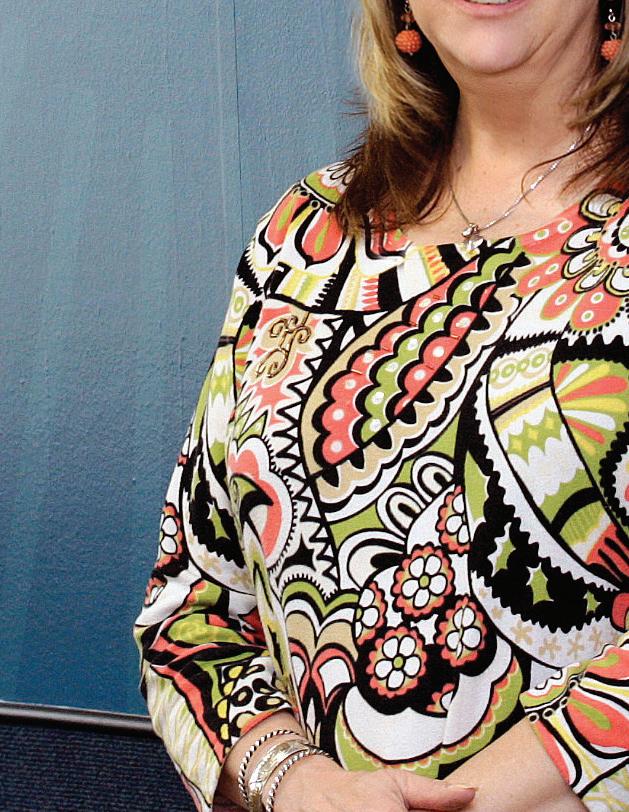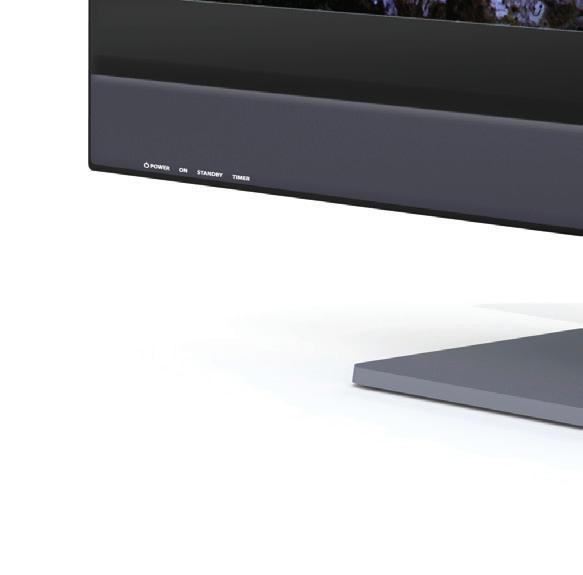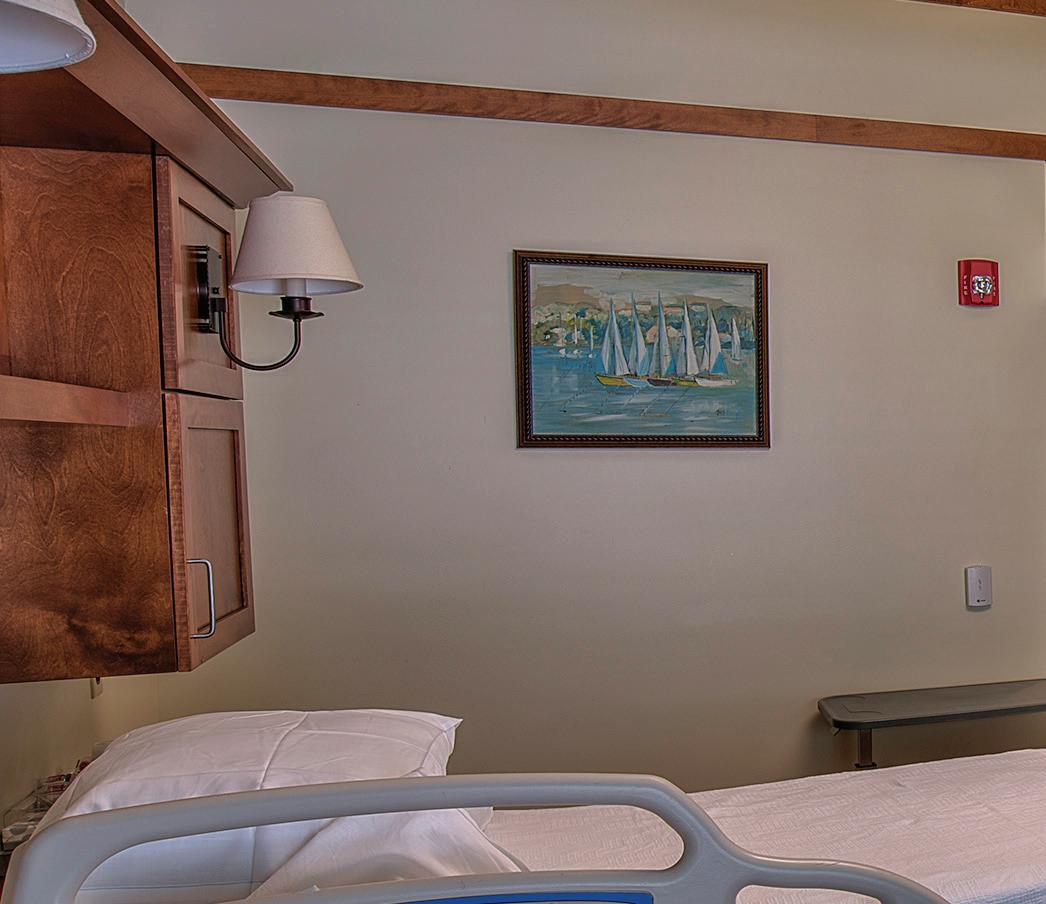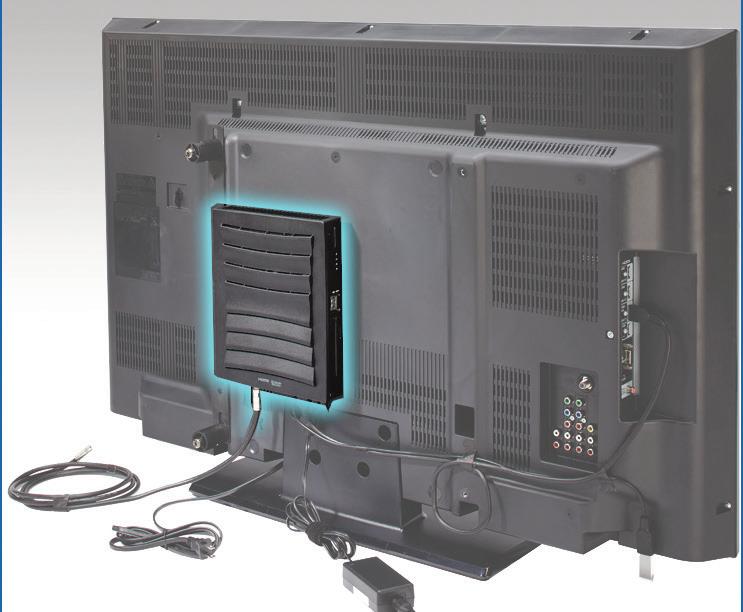
22 minute read
Alphapointe: Vision Accomplished
by ⌘ ⇧ ⌥


ALPHAPOINTE FOUNDATION EXECUTIVE DIRECTOR GINA GOWIN



Alphapointe: Vision Accomplished A nonprofi t leverages technology to train the sight-impaired.
THE CHALLENGE: For more than a century, nonprofi t Alphapointe has provided rehabilitation and occupational services—including a technology camp, adaptive technology, job training, and more—for people with vision loss. Last year, Alphapointe doubled its size by merging with New York City Industries for the Blind (NYCIB), giving it a total of 400 employees operating in nine locations in four states. The organization needed fast and roomy bandwidth to provide leading-edge technology to its clients and employees, as well as to connect remote locations in Arkansas, Nebraska, Missouri, and New York to the Kansas City, Missouri, headquarters. Further, Alphapointe needed to simplify operations by consolidating all of its IT, customer support, and fi nancial accounting services in one location.
THE SOLUTION: Time Warner Cable Business Class (TWCBC) has been helping Alphapointe achieve its mission since 2009, when it installed fi berbased Dedicated Internet Access (DIA) and a fi ber Primary Rate Interface (PRI) circuit for voice. At the time of the 2014 merger, it was a simple matter for Alphapointe to call TWCBC to upgrade to 100 Mbps DIA and add a second fi ber PRI circuit. Alphapointe has been able to use DIA’s symmetrical upload and download connectivity to seamlessly connect its locations via Virtual Private Networks (VPNs). DIA also powers Alphapointe’s primary revenue engine: its online retail business for offi ce supplies, plastics, and other products. Meanwhile, the robust fi ber PRI voice solution has provided a real-time portal for managing usage details and reporting capabilities.
THE RESULTS: The merger with NYCIB went smoothly. “Our current solutions from Time Warner Cable Business Class did not require any adjustments or changes,” says Stan Wright, Alphapointe’s IT director. “That enabled us to focus on getting the New York site migrated and rolled in.” In addition to consolidating back-office operations, Wright could relax with the knowledge that TWCBC’s service level agreement (SLA) would maintain uptime between different locations. Moreover, the reliability and scalability of the TWCBC solutions allowed Alphapointe to move its call center business from a college campus 50 miles away to a new 60-seat, state-of-the-art facility located in the agency’s Kansas City headquarters.
Most important, Alphapointe relies on TWCBC’s advanced technology to remove barriers and advance its mission for the visually impaired. Whereas the organization traditionally has focused on helping its community train for manufacturing jobs, it now needs to be responsive to the desire of younger generations to have access to white-collar jobs. “Students come here to learn accessible software and services they’re going to use in college, or in a job—perhaps even in telework,” says Gina Gowin, executive director of the Alphapointe Foundation. Adaptive technologies and apps help students overcome daily challenges and socialize with friends. “Think about things like making a phone call, turning on the news, or surfing the Web without sight,” Gowin says. “That’s all technology that Time Warner Cable Business Class provides us so we can help enrich our students’ lives.”
SHARE YOUR STORY! How did you partner with TWCBC to SOLVE your technology issues? Tell us about it for a chance to be featured in an upcoming issue of SOLVE. Visit business.twc.com/nomination to share your story.
ENHANCING PRODUCTIVITY CONNECTING MULTIPLE LOCATIONS INCREASING COLLABORATION REDUCING CAPITAL EXPENSES PLANNING AND PROCUREMENT ROUTER SETUP
MANAGEMENT SOFTWARE STRATEGIC INITIATIVES SOFTWARE UPGRADES AND PATCHES TRAINING STAFF ONGOING MAINTENANCE

AS YOUR BUSINESS EXPANDS, THERE’S A LOT ON YOUR MIND.
Why not put it on our shoulders?
With Managed Router Service for Ethernet, you can focus on moving your business forward, because we’re focused on almost everything else.
Enjoy fullymanaged, turnkey high-bandwidth WAN connectivity and management Reliably link two or more sites for increased collaboration Benefit from a predictable monthly rate and avoid the cost of implementing and managing your own systems Free up your IT staff to concentrate on more strategic initiatives
Call to schedule a free technology audit with a local, dedicated Account Executive today, or visit us online to calculate how much your business could save with Managed Router Service! 877.857.0727 | TCO.NETWORK-NEEDS.COM
How HDTV and technology amenities lead to an improved patient experience—and a competitive edge POWER TO THE PATIENT


Does it matter what’s on TV in a hospital room? To the patient, who may be bored, restless, or seeking distraction, it does matter—a lot. A patient who is satisfi ed by the choices available is a happier patient, with a greater sense of control—and that fact makes “what’s on TV” a matter of concern for hospital administrators, too. Technological advances are, of course, rapidly revolutionizing the way medical treatment, from diagnosis through after-care, is delivered. (For more on this hot topic, see “Health Care’s New High-Tech Touch” from the SOLVE Spring 2015 issue at business. twc.com/spring2015)


12 Fall 2015 In recent years, however, hospitals and other health-care facilities have realized that fi rst-rate medical care must be combined with an increased attention to the patient experience. Connectivity is creating new best practices for patient in-room services, especially in the areas of High-Defi nition Television (HDTV) and Internet access.
It’s also creating new opportunities to attract patients to a health-care facility. “Amenities play an increasing role in the competition for market share,” noted a report in the New England Journal of Medicine. And when it comes to preferred amenities, the consumer has spoken: a majority of patients in the United States would

switch facilities for better entertainment and food options, according to consulting fi rm McKinsey & Company. Hospital administrators also know that a happier patient will result in a higher rank on the Hospital Consumer Assessment of Healthcare Providers and Systems surveys (better known as HCAHPS, pronounced H-caps). Satisfi ed patients also share their opinions through word of mouth and via social media.
With so much competition in health care, and the importance of patient satisfaction scores to Medicare and Medicaid reimbursement, a robust digital offering—once considered a luxury—has become a necessity.
out 2 of 3




patients are willing to switch hospitals for improved in-room entertainment and food options


SOURCE: MCKINSEY QUARTERLY
In-house channels can provide soothing images.
Small-Screen Solutions
Among the most valued experiences for
patients is the availability of HDTV. That’s
because consumers are accustomed
to this viewing experience—in fact, 77
percent of American households now
have at least one HDTV set, and those
who subscribe to a video service enjoy an
average of 82 channels of programming. 1
Further, while they have their choice
of electronic media options, American
consumers continue to spend the most
time with television—an average of fi ve
hours per day. 2
To provide patients and their families a home-like experience, then, healthcare facilities are increasingly offering comprehensive HD video programming services. “People don’t think a television could be that important, but it really is,” says Joseph Gunnels, IT technical manager for Hospice Buffalo, the center for palliative care in Buffalo, New York. “It really comforts the patient. They can watch TV, which is important when there’s nowhere to go.”
In addition to cable and broadcast HD video, hospitals are providing ondemand delivery of movies and other content, thus avoiding the complexity of managing movie libraries, and giving patients instant, around-the-clock access. Beyond providing entertainment, TV can play a therapeutic role. Hospice Buffalo’s service through Time Warner Cable Business Class (TWCBC), for example, allows them to offer custom channels that support clinicians in providing music, relaxation, and expressive therapies. These include live underwater video from the hospice’s breathtaking saltwater aquarium, as well as live video from rotating outdoor cameras that allow patients to enjoy the hospice’s gardens and courtyards even while lying in bed.
SOURCE: THE NEW ENGLAND JOURNAL OF MEDICINE
70%
of health-care leaders say focusing on patient experience is a top priority
SOURCE: THE BERYL INSTITUTE
SOURCES: 1. HDTV XI, LEICHTMAN RESEARCH GROUP, MARCH 2014 2. “AN ERA OF GROWTH: THE CROSS-PLATFORM REPORT,” NIELSEN, MARCH 2014 3. PEW RESEARCH CENTER, “OLDER ADULTS AND TECHNOLOGY USE,” APRIL 2014

ANATOMY OF A CONNECTED EDGE:
Fast, Reliable Connectivity + Ease of Communication with Family and Friends + Ability for Visitors to Work from Health-Care Facility + Online/Onscreen Education about Health-Care Issues + Range of TV Entertainment Choices = Contented Patients + Higher Patient Satisfaction Scores


People don’t think a television could be that important, but it really comforts the patient. They can watch TV, which is important when there’s nowhere to go. —JOSEPH GUNNELS, IT TECHNICAL MANAGER FOR HOSPICE BUFFALO
Further, health-care facilities can take advantage of HDTV for on-demand video solutions. These solutions provide required medical educational information that empowers patients and their families to participate more actively in their care. Fortunately, a leading-edge solution called a set back box (see sidebar, right, “Channeling Patient Satisfaction”) can deliver this highly valued amenity in a scalable and cost-effective way.
The Internet Advantage Health-care facilities, including assisted living centers and nursing homes, are fi nding that fast and reliable Internet access is also critical to a good patient experience—and to remaining competitive. Take, for example, senior citizens,
whose increasing share of the population
is spurring demand for senior housing.
This group is among the fastest-growing
segments of Internet users in the United
States: about two-thirds of Americans
in their early seventies regularly use
the Internet, and more than half have
broadband at home. (Among higher
income seniors, those numbers are 90
percent and 82 percent, respectively. 3 )
When it comes to senior housing options, these connected older adults and their family members are looking for the just-like-home experience of fast, reliable Internet. In large part, that’s because going online provides a crucial lifeline to keeping in touch with family and friends, allowing residents to
easily get news and photos and virtually “attend” a family event.
One of the largest providers of assisted living for seniors in the United States recently launched a pilot program that takes connectivity a step further by offering a mobile device rental program. “A daughter, 73, and mother, 93, both got iPads at the same time, and they have been FaceTiming every single day. She and her mom connect because of this project,” says the senior care company’s technology director.
Internet access benefi ts families in other ways, as well. At Hospice Buffalo, Gunnels points out, family members sometimes end up staying with loved ones 24 hours a day for weeks on end. Fiber Internet access keeps them connected to their work—and without it, many people couldn’t be there for loved ones. To meet this need, Hospice Buffalo relies on TWCBC’s 10 Mbps fi ber-based symmetrical Dedicated Internet Access (DIA).
The bottom line: high-quality connectivity has become a business necessity for health-care facilities, from hospitals through senior living and skilled nursing facilities. It offers a powerful way to enhance patient or resident care, as well as to provide amenities that boost occupancy, revenue, and satisfaction.
Increasingly, the question for medical centers and nursing homes is not whether to upgrade their connectivity for patients, but when. By partnering with a service provider that can enable leading-edge cloud and collaboration applications, as well as a just-like-home broadband Internet and HD video experience, healthcare facilities gain an edge in today’s competitive market.
TELEMEDICINE SOLUTIONS To learn about how connectivity is transforming the delivery of medical care, see “Health Care’s New High-Tech Touch” in the Spring 2015 issue of SOLVE at business.twc.com/spring2015
CHANNELING PATIENT SATISFACTION TWCBC’s HD video for health care is comprehensive and convenient. Health-care TV programming from Time Warner Cable Business Class (TWCBC) helps patients rest easy—and eases the burden on hospital administrators, heads of IT, and facilities managers as well.
CUSTOMIZABLE CHANNEL GUIDE THE RICH VARIETY OF PROGRAMMING CHOICES INCLUDES: • Real-time access to news, business,
sports, family, and entertainment channels • Family-friendly channels, including Nickelodeon, Food Network, National Geographic, and Discovery
• Programming to suit every patient, including
A&E, ABC Family, BET, Bravo, Cartoon Network, CMT, CNN, Comedy Central, Fox News Channel, HGTV, History, Lifetime, and more
SUPERIOR SERVICE Installation is hassle-free and quick, and support is available 24/7. Minimal exposure to the elements, thanks to delivery through TWCBC’s reliable, fi berrich network, means a consistently clear digital or HD picture. Hospital administrators appreciate one of the service’s key features, the set back box, which mounts discreetly behind any HD television. The set back box doesn’t require costly head-end equipment or rack space, making it costeffective as well as convenient. Most importantly, the set back box delights patients by providing a range of interactive services—including a userfriendly menu guide, parental controls, closed captioning, and more—all through the use of a simplifi ed, anti-microbial remote control. Viewers enjoy poweron channel management, which sets a favorite channel when the television is powered on; on-demand bookmarks, which allow users to return and restart programs where they left off; and the ability to pause live TV, fast forward, or rewind up to 60 minutes. Facilities can choose their offering from a full portfolio of HD programming, with access to more than 100 HD channels and thousands of free ondemand content choices. Health-care facilities can also reinforce their brand by including their company logo within the customizable channel guide.

WINNING THE CUSTOMER





HOW TO CREATE AN AMAZING EXPERIENCE
What do your customers expect from your company? Nothing less than the excellence and ease provided by Zappos or Apple. Today, in fact, customer experience is where the action is: nine out of 10 marketing leaders believe that their companies will be competing mainly on that basis by 2016, according to Gartner, Inc. technology research. The good news: mid-market companies are well-placed to not only compete, but win on this new battleground for customers.
THREE EXPERTS GIVE HANDS-ON IDEAS FOR PROVIDING EXCELLENCE
THE CUSTOMER












Your customer experience can be your biggest competitive advantage. To achieve this, your employees— whether accountants or account execs, the CEO or the janitor—must be committed to “owning the moment” in every interaction with a client or customer. They have to be in the moment, not thinking about the 5:30 conference call or the cheeseburger they’ll be having for lunch. Use what I call the 5 Es. The fi rst three of these take one second to do simultaneously. The fi rst two are an Enthusiastic Greeting and an Ear-to-Ear Smile. (In my offi ce, we put mirrors on our computer monitors because smiles can be “heard” over the phone.) If it’s an in-person interaction, the third E is make Eye Contact. Always Educate. Explain something a little more thoroughly, so that the client leaves with more information than he or she had before. The fi nal E stands for Engage, and this one is the key. Don’t just take the Person to Person: The Simple Secret to Connecting An interview with John Di Julius John Di Julius is the founder of the John Robert’s Spa chain in Cleveland, Ohio; CEO of The DiJulius Group, a customer experience consulting fi rm; and the author of two bestselling books, including The Customer Service Revolution and What’s the Secret? To Providing a World-Class Customer Experience. In an interview, he shared some of his best tips with SOLVE readers.
The 5 Es of Great Customer Experience Enthusiastic Greeting Ear-to-Ear Smile Eye Contact Educate Engage
customer’s order or fi nd out what he or she wants; talk to him or her. It doesn’t take long. Engage means you pick up on some information about the person—the diploma on the wall, the nice hat—and build rapport by making
a comment. It could be as simple as, “I see you’re a Buckeyes fan,” or “Isn’t this warm weather great?” Engaging makes the difference between a transaction and an interaction. This advice is relevant for any department that interacts with customers. In our offi ce, we have a fi rm rule that you must use the other party’s name two or more times in the conversation or email. And you can’t respond to an email without personalizing it in some way.
For example, when my company’s accounts receivable manager sends a bill, she includes a personal note in the email: “Hi, {name}, I hope the weather where you are is better than in Ohio!,” or perhaps a comment about the recipient’s local sports team. If someone is paying attention to you like that, you want to pay that bill fi rst. Customers always overshare; they’ll tell you they have to reschedule because of a daughter’s recital, for example. Your employees shouldn’t be so work-focused that they miss the chance to capture customer intelligence. The following week they can ask, “How was your daughter’s recital?” Finally, every interaction should end with this question: “Is there anything else I can do for you?” Now, what if you’re a professional services provider? Most offi ces don’t get many visitors—maybe a half dozen a week, or even a month. Why should the receptionist merely ask for a client’s name and who he’s here to see, then tell him to have a seat? After all, how many 2:00 appointments does Tony Smith, Esq., really have? Why not have a monitor with a screen that says “ABC Law Firm welcomes {client name}, we’re happy to see you!”? It’s a small investment of effort that leads to a “wow.”
Follow these practices and I guarantee the takeaway for your customers will be that yours is a company they want to do business with.
Excellence Requires a Low-Effort Experience

BY DAVID LLOYD

For two out of three people, the customer journey starts online, with the majority of customers moving to a live agent—call centers or chat—only if online self-service options are not delivering. Knowing this, companies need to focus on providing the optimal experience for customers across all digital channels.
Most of the technology solutions mid-market companies can use to drive a better customer experience are very accessible from a sophistication and cost point of view. There are three layers companies need to consider:
Prediction Predictive platforms look at the breadcrumbs customers have left along their journey in order to better anticipate their needs. They vary in their functionality from simply tracking what a customer is clicking, as with HP’s Autonomy or Adobe Analytics, to using models that represent customer behaviors and journeys, such as [24]7 ’s prediction layer that integrates with virtual agent and chat solutions.
Of course, if your customer is already in your CRM system, and has logged in, you have the benefi t of even more detailed customer insight. For example, maybe you know that this person’s account is locked, so they’ll likely to be logging on to pay their bill.
Virtual agent This is artifi cial intelligence that interacts with the customer digitally. This technology can take shape in a chat-style service, for web or mobile. Based on what is known from predictive data, the virtual agent can hone in on what may be needed. Solutions from NextIT and Creative Virtual provide sophisticated virtual agents that can engage in a dialogue with the customer to resolve a problem.
Right-channeling Depending on the customer’s response and what is known about him, the virtual agent can continue the dialogue or direct the customer to the optimal channel, depending on rules the company chooses. As the customer is transferred, his information (or context) must be transferred as well, so that the experience is seamless.
The key to providing a low-effort customer experience is fi nding a set of solutions that support your growth. Ideally, your vendor will have effectively brought together all three, while allowing you to start with certain aspects of the platform and grow into the rest.
David Lloyd is president of IntelliResponse, the leading provider of virtual agent technology solutions for private and public sector customers.
Let Technology Help You Treat Your Customers Right

BY TOM BYUN
Whether your business is B2B or B2C, providing a good customer experience is more of a competitive differentiator than ever before, and is therefore critical to your success. So, what are some of the offerings you need to be thinking about to provide a great customer experience?
There is no one-size-fi ts-all answer. First, you should consider your overall needs for implementing a customer experience strategy.
What are your customers’ typical issues, and how can you best address them?
Do they need immediate access to customer service for urgent problems? Or are they mainly contacting you because they haven’t received their package yet? Which channels—telephone, email, chat, messaging—do they typically use to communicate with you?
What do you want to achieve with customer experience technology?
There are two main goals that most companies have. One is cost savings, as in cutting down on time spent dealing with customer issues, returns, or complaints. The other is sales, as in acquiring new customers, increasing the average order value for existing customers, or improving customer lifetime value through loyalty. By looking at your customer experience holistically, with the big picture in mind, you can begin to drill down to specifi c channels, such as these:
Live phone help This may be a priority if your customers have serious, time-sensitive matters, such as legal or medical issues.
Self-help If your customer would benefi t from having common, but complicated, matters spelled out in white papers or FAQs, you should consider providing more information on your website. (This material also doubles as valuable information you can proactively push out to potential customers.)

Moderated community In certain fi elds, particularly IT, customers are inclined to seek answers and fi nd vendors by going on blogs and forums. You can have a moderated website with robust content, and embed a proactive chat or message window there.
Live chat One form of customer support that is proliferating rapidly is live chat. Research shows that a chat session costs approximately $1 to $2 per minute, while the cost of a phone representative is $6 to $12 per minute, mainly because a chat agent can handle several chats at a time. Research has also shown that shoppers who use chat convert at three times the rate of those who don’t.
Mobile If you’ve got a busy, on-the-go customer base, mobile messaging and texting might be the platform for you. With an optimized mobile site, or a messaging app for business (similar to Facebook Messenger or WhatsApp), you can engage customers when and where they like.
Certain consumers prefer to communicate entirely on their own time, and don’t want to risk being put on hold, or even to spend time on a phone or web real-time session. For them, an asynchronous messaging system—which allows customers to send questions when they have them and get answers when an agent is available—works best.
Questions for Your Vendor It’s easy to deploy and test a multitude of customer experience offerings, from cloud computing to analytics. As a result, there are a lot of startups in the customer service space. Make sure a potential vendor can provide satisfactory answers regarding the following: uptime reliability (at least 99.9 percent); the backup and business continuity plan; security compliance; compliance with your industry’s standards and regulations; and integration capabilities with your existing customer relationship management (CRM) system and data.
Finally, remember to think ahead. What if you hit major spikes in activity during a particular campaign or business cycle? Many mid-market companies experience hypergrowth in sales or support volume. Make sure your customer experience infrastructure will be able to scale along with your company.
Tom Byun is general manager and senior vice president of the global small business division of LivePerson, a leading provider of digital engagement solutions.








